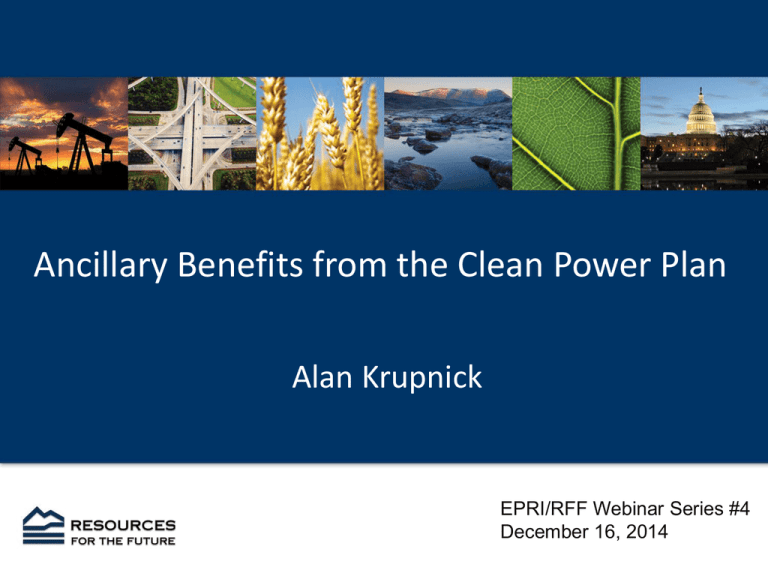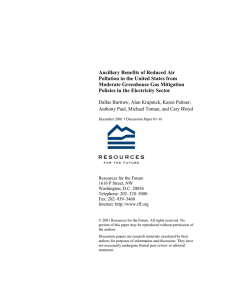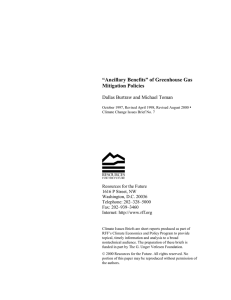Ancillary Benefits from the Clean Power Plan Alan Krupnick
advertisement

Ancillary Benefits from the Clean Power Plan Alan Krupnick EPRI/RFF Webinar Series #4 December 16, 2014 Can the CPP be justified from ancillary benefits alone? • Ancillary benefits are side effects of a policy Conventional air quality benefits of a climate policy • The USEPA estimates the costs and benefits of a proposed policy in a Regulatory Impact Analysis, required by Executive Order • Ancillary benefits typically included • For the CPP (2025) o Costs = $5.5 B o Ancillary benefits >= Climate benefits o Climate benefits > Costs YES! Details/Critique of Ancillary Benefits Pollutants affected by CPP • PM2.5 precursors o Black carbon o Particulate organic matter (POM) o Sulfur dioxide (SO2) KEY o Nitrogen oxides (NOx) • Ozone precursors o Nitrogen oxides (NOx) o Volatile Organic Carbons (VOCs) Associated climate impacts of black carbon, SO2, etc. not calculated in RIA Air quality modeling • Continental U.S. coverage • Base year for emissions and meteorology is 2005 • Utility emissions estimates for 2016 are from IPM o Include reductions related to NOx SIP Call, Transport Rule, MATS • Source apportionment from CMAQ and a study • No bottom up modeling of change in emissions Health effects Most significant health benefit for both pollutants is mortality o 98% of PM monetized value, >90% of ozone value • Adult PM-related mortality: the American Cancer Society cohort (Krewski et al., 2009) and the Harvard Six Cities cohort (Lepeule et al., 2012). Using relative risk estimates from both studies & expert elicitation study (Roman et al., 2008; IEc, 2006) • Co-benefits avoiding short-term ozone mortality: Bell et al. (2004) NMMAPS analysis, the Schwartz (2005) multi-city study, the Huang et al. (2005) multi-city study , and 3 meta-analyses: Bell et al. (2005), Levy et al. (2005), and Ito et al. (2005) Economic benefits for health co-benefits • Premature deaths: value of a statistical life (VSL) approach o EPA working to update VSL guidance o Currently, uses single estimate: $8.2 million (2011$) • Discount future mortality 3% and 7% • Assumes “cessation” lag between exposures and health effects • WTP estimates for changes in risk of a health effect o For some health effects, cost-of-illness estimates are used (generally underestimate value) • Benefits are calculated at regional level (East, West, and California Other quantified effects • PM 2.5 (PM Integrated Science Assessment, 2009) o o o o o Non-fatal heart attacks Hospital admissions Asthma and respiratory systems Lost work days Minor restricted-activity days • Ozone (Ozone Integrated Science Assessment, 2013) o o o o Hospital admissions – respiratory causes Emergency department visits Minor restricted-activity days School absence days Economic benefits for PM2.5 EPA’s take on modelling issues All estimates reflect geographic distribution of modeled emissions, which... o May not match reductions anticipated by guidelines o May not reflect local variability in population density, meteorology, exposure, and baseline health incidence o Assumes linear atmospheric response to emission reductions (largely accurate for SO2 but not NOx) Economic benefits for Ozone EPA’s take on modelling issues All estimate reflect geographic distribution of modeled emission, which are similar to those of PM 2.5 except … o Are equal to the sum of premature mortality and morbidity of reducing NOx Not VOC o Based on NOx emissions during the ozone season (May - September), which is an underestimate in areas with longer ozone season o NOx contribution to ozone is non-linear, and thus using average benefit-perton estimate adds uncertainty Other issues • What’s in the baseline? o MATS; Transport Rule, etc. o Not: New Ozone Regs, PHASE I and II, 2012 CAFÉ • What’s being assumed for the policies? o Ancillary benefits are sensitive to form and stringency Ancillary benefits depend on structure of the regulation Equal (400 mty) CO2 reduction across scenarios: three policies 2020 Carbon Tax National Emissions Rate Standard Cap and Trade with Allowance Value to LDCs 1,417 1,332 1,349 -3 -7 -7 16 16 16 17 22 21 (2010$) Fossil Emissions Rate (lbs/MWh) Total Welfare Change: Cost (B$) Total Welfare Change: CO2 Benefits (B$) Total Welfare Change: SO2 Benefits (B$) Final structure depends on state compliance plans! Burtraw, Linn, Palmer, Paul 2014; AER P&P Other issues ctd. • What’s in the baseline? – New Ozone Regs, PHASE I and II, 2012 CAFÉ • What’s being assumed for the policies? – Ancillary benefits are sensitive to form and stringency • Are there thresholds in health effects? Where? o Implication of NAAQS • Mortality C-Rs • VSL Fraas and Lutter: factor of 10 lower AB • No confidence intervals, only CR mortality model uncertainty Other issues ctd. Does not include: • Health effects from direct exposure to NOx and Sox • Ecosystem effects • Visibility impairment Conclusions • Ancillary benefits are legitimate and appropriate for the RIA • Further benefit of legitimizing making ancillary benefits primary and CO2 benefits ancillary • Some issues lead to underestimates of AB • Some lead to overestimates • Lots of overarching uncertainty – statistical uncertainty not addressed; model uncertainties very limited








